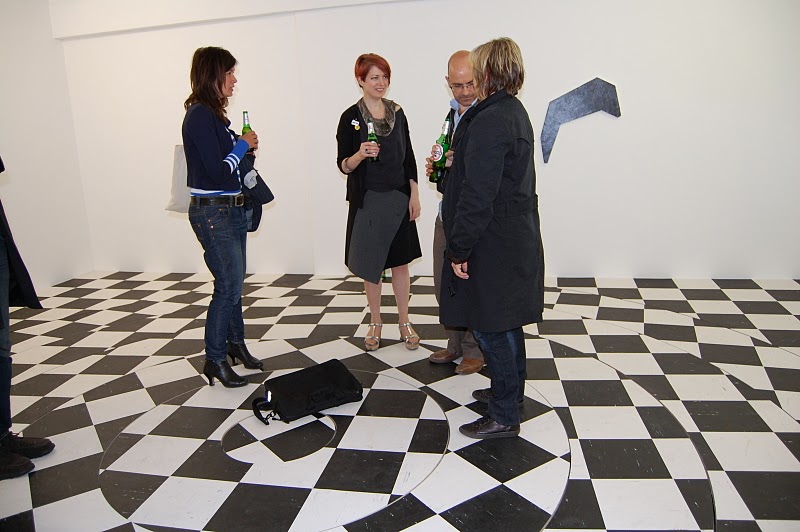LAZY DUSTIN
Black-and-white tiling in Renaissance and neo-classical painting is often used to demonstrate the rules of perspective: foreshortening, narrowing lines delineate, with quantifiable accuracy, how single-point perspective would be perceived from a certain vantage point. Dustin Ericksen’s LAZY DUSTIN appears to engage with this type of scenario. His installation evokes a tiled floor of some kind of public space, as these paintings often depicted, but as one spends time with the work it becomes clear that his use of perspective has radically different intentions. In LAZY DUSTIN, one is invited to step onto the floorboards, into the work, and to become part of the shifting alignments of concentric circles that not only confound represented perspective but handcuff it to motion, positing and scrutinising the idea of perspective-in-motion.
Such ideas of motion and perception have appeared elsewhere in Ericksen’s practice, which is concerned with social spaces, information and the individual. In the publication Simian’s Way: He Decided to Walk to Repay the £20, produced for the Sharjah Biennial 6 (2003), Ericksen reproduces commercial signs from along the Kingsland Rd., in Dalston. Rather than being seen in a frontal view, the signage (‘American’ nail bars, off-licenses, taxi companies) replicates the perspective of someone walking down the road, much as Robert Venturi and Denise Scott Brown instructed that architecture should take into account the fact that most buildings are seen at 35mph from inside a moving car. In Simian’s Way, the rectangular signs are rendered as anamorphic shapes, suggesting, within their static forms, the motion of the pedestrian who perceives them.
The paintings on the wall of this exhibition derive from that project. They are rendered again obliquely, and here are painted over in a colour scheme that alludes to Blinky Palermo’s To the People of New York City (1977–78), wall paintings in the colours of the German flag that Palermo installed throughout New York, as if they were commercial signs. Ericksen’s versions of the paintings, which he saw first in the city, are mellowed – greys, pinks, and pale yellows, and black – and the act of painting over the sign performs both this operation of private, though art-historical, memory, through the evocation of To the People…, and one that continues the exploration of perception begun in Simian’s Way. By leaving out the content of the sign, Ericksen obscures the sign’s referential content while preserving its form as the shape of what you might see as you walk by: the work becomes a percept of motion. Though odd in its static form, the shape is intuitively righted when perceived. The paintings require a subject in movement – not a contemplative one, and not one in the habit of pausing to assign perceptual weight to some objects over others. This different subject, one with such awareness of his conditions of perceiving, is part of what LAZY DUSTIN seeks to install in the space.
The installation, Ericksen says, is intended to turn so slowly that one barely notices the movement. The act of noticing the movement – perhaps the goal of the piece – is a process of readjustment, of perceiving oneself perceiving, and, ultimately, of perceiving the instantaneity of every subsequent vantage point. Much in the same way that epistemology differentiates between knowing how and knowing what (kennen, connaître vs wissen, savoir), the ancient Greeks distinguished between two types of time: chronos and kairos, and in LAZY DUSTIN Ericksen rejuvenates this latter sense. Chronos is chronological, consecutive time, while kairos denotes the more instantaneous idea of the ‘occasion’, or the best time for something to occur. It remains, post-ancient Greece, in the rhetorician’s use of kairos, which is the adaptability of an argument to whatever is thrown at it, or its best possible shaping in that context, and in the theosophical sense of the Bible’s kairetic time, which is time inflected with eternity. In LAZY DUSTIN’s set of visibly changing circumstances, Ericksen attempts to demonstrate – provide a visual metaphor for – the fact that one’s position will always be in relation to a (shifting) context. The discreteness of each moment within this context, much like the attempt to fix a representation of motion – motion as distance over time – in the wall paintings, is one offered by kairos, in its notion of readiness or the ‘right’ time. By using this now secondary understanding of time, LAZY DUSTIN offers up a model for a succession of moments, each liberated from each other and made available, as new vantage points of perspective, to the viewer.
Melissa Gronlund,
May 2009





